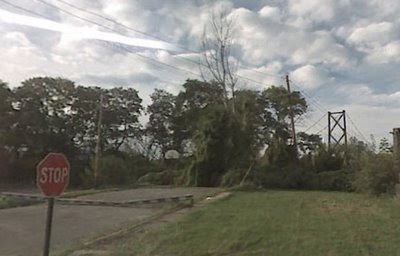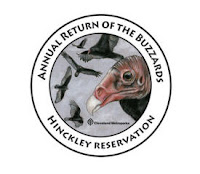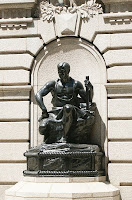 There are many big museums in Cleveland but one that is not as well known is the Cleveland Police Historical Society Inc. and Museum, which is located on 1300 Ontario St, on the first floor of the Justice Center.
There are many big museums in Cleveland but one that is not as well known is the Cleveland Police Historical Society Inc. and Museum, which is located on 1300 Ontario St, on the first floor of the Justice Center.Founded in 1983, it came to be as a result of the efforts of a group of Cleveland policemen and area citizens. The idea was hatched as a result of a visit to Scotland Yard’s Black Museum in London, England by Cleveland Police Detective Robert Bolton, who then convinced Chief William Hanton that Cleveland should have its own police museum. Over a period of 7 months, members of the department and private citizens worked together to create a nonprofit historical society. At first, the museum was only was allotted 1200 sq. ft. of space on the first floor of the Justice Center, and 4 years after its founding, the museum was one of only 12 of its kind in the United States. It received visitors not only from local areas but also from around the world. It features exhibits documenting the history of the Cleveland Division of Police from its inception in 1866, and differentiates itself from other museums of its kind as it is funded completely by private citizens and is not controlled or funded by the Cleveland Police Department or state or federal tax dollars.
The museum now has a larger area than when it began, currently with over 4,000 square feet of space. It continues to work to preserve the history of the police department, in addition to fostering a better understanding of the role of law enforcement within the community. My husband’s grandfather was a police officer in Cleveland from the late 1920s to the early 1940s, so the family has a great appreciation for the police officers that are on the front lines of keeping Clevelanders and the city's visitors safe. It’s nice to know that their efforts are being recorded and maintained for future generations to appreciate.
If you would like more information on the Cleveland Police Historical Society Inc. and Museum, you can visit their web site, here.

Check out my blog home page for the latest Cleveland information, here.
















 I’ve always been interested in geology. Not seriously, though. As a kid I liked to pick up all kinds of rocks, much to my mother’s dismay. When I was in my first few years at grade school in Brooklyn, Ohio, we lived right across from the steep cliffs of Big Creek. In fact, we used to play in the creek all the time and picked up quite a few small fossils in the shale there. Unfortunately for us, in 1964 when the State of Ohio decided that they were going to put I-71 right through our living room, our family had to quickly relocate. But it seems that our misfortune meant a boon for paleontologists, who also found lots of fossils in the area as the area was reconstructed for the freeway. From I-71 near Ridge Road, one can still see the remainder of the street, and the shale filled cliff of the area where Big Creek travels.
I’ve always been interested in geology. Not seriously, though. As a kid I liked to pick up all kinds of rocks, much to my mother’s dismay. When I was in my first few years at grade school in Brooklyn, Ohio, we lived right across from the steep cliffs of Big Creek. In fact, we used to play in the creek all the time and picked up quite a few small fossils in the shale there. Unfortunately for us, in 1964 when the State of Ohio decided that they were going to put I-71 right through our living room, our family had to quickly relocate. But it seems that our misfortune meant a boon for paleontologists, who also found lots of fossils in the area as the area was reconstructed for the freeway. From I-71 near Ridge Road, one can still see the remainder of the street, and the shale filled cliff of the area where Big Creek travels.















 The gardens had faced some periods of neglect, theft of some of the greenery, and vandalism of some of the stone and metal works. Frankly, the last time I drove through the area (only a few months ago) I found myself somewhat saddened to see no one walking though the park. While it doesn’t look neglected, it is clear that the city has not capitalized as much as it should on what can be a stunning green space. It certainly makes for a nice drive through, but is not welcoming to just stopping your car to admire the area. Parking is impossible along MLK Blvd., so if you plan to visit, you may have to park at the Rockefeller Park Greenhouse at the north end of the park and walk, or, in other locations in the neighborhood on East Blvd. near Sam Miller Park. There may be other parking locations that are available of which I am not aware.
The gardens had faced some periods of neglect, theft of some of the greenery, and vandalism of some of the stone and metal works. Frankly, the last time I drove through the area (only a few months ago) I found myself somewhat saddened to see no one walking though the park. While it doesn’t look neglected, it is clear that the city has not capitalized as much as it should on what can be a stunning green space. It certainly makes for a nice drive through, but is not welcoming to just stopping your car to admire the area. Parking is impossible along MLK Blvd., so if you plan to visit, you may have to park at the Rockefeller Park Greenhouse at the north end of the park and walk, or, in other locations in the neighborhood on East Blvd. near Sam Miller Park. There may be other parking locations that are available of which I am not aware.
